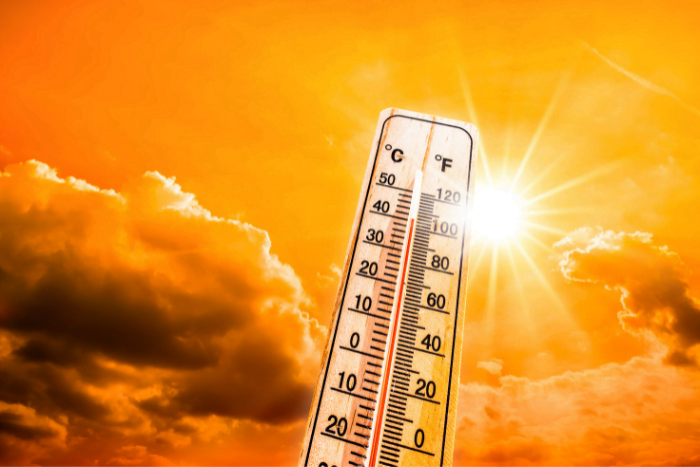In South Asia, 30-day heatwaves can be expected to occur about once every 30 years and have already become about 45 times more likely and 0.85°C hotter due to climate change, says a new study
Extreme temperatures above 40°C, which impacted billions of people across Asia in April, were made hotter and more likely by human-caused climate change, according to rapid attribution analysis by the World Weather Attribution group.
In South and Southeast Asia, Myanmar, Laos and Vietnam broke records for their hottest April day, and the Philippines experienced its hottest night ever. In India, temperatures reached as high as 46ºC. Heat-related deaths were widely reported, with at least 28 in Bangladesh, five in India and three in Gaza during April, while surges in heat deaths have also been reported in Thailand and the Philippines this year. The heat also led to crop failure, loss of livestock, water shortages, mass die-off of fish, widespread school closures, and the heat has been linked to low voter turn-out in India.
The heat was also extreme in West Asia, with Palestine and Israel experiencing temperatures above 40°C. The month was the hottest April on record globally and the eleventh consecutive month in a row a hottest month record was broken.
Quantifying the impact of climate change
To quantify the effect of human-caused warming on the extreme temperatures across Asia, scientists analysed weather data and climate models using peer-reviewed methods to compare how these types of events have changed between today’s climate, with approximately 1.2°C of global warming, and the cooler pre-industrial climate.
The analysis focused on the periods when the heat was most dangerous in two regions: the three-day average of maximum daily temperatures in a region of West Asia that included Syria, Lebanon, Israel, Palestine and Jordan, and the 15-day average of maximum daily temperatures in the Philippines. The scientists also analysed the possible influence of the El Niño–Southern Oscillation, a naturally occurring climate phenomenon that shifts between El Niño, neutral and La Niña conditions.
Climate change making heatwaves more likely
In West Asia, the scientists found that April heatwaves with temperatures above 40°C are more frequent due to warming caused by human activities. In today’s climate, with 1.2°C of warming, similar heatwaves are expected to occur about once every 10 years.
The study said that climate change made the heat about five times more likely and 1.7°C hotter. In the future, extreme temperatures in West Asia could become even more frequent and intense. If warming reaches 2°C, as they are expected to in the 2040s or 2050s unless emissions are rapidly halted, similar heatwaves will occur about once every five years and will become another 1°C hotter, the study warned. El Niño does not have an influence on the high temperatures in West Asia
According to the study, in the Philippines, similar heatwaves are expected to occur about once every 10 years during El Niño conditions and about once every 20 years in other years without the influence of El Niño. Without human-induced climate change, such an event would have been virtually impossible, even under El Niño conditions, the scientists found. Overall, climate change made this year’s heatwave 1°C hotter, while El Niño made the heatwave a further 0.2°C hotter. If global warming reaches 2°C, similar heatwaves in the Philippines will occur every two to three years and will become another 0.7°C hotter
In South Asia, the study estimated, similar 30-day heatwaves can be expected to occur about once every 30 years. However, they have already become about 45 times more likely and 0.85°C hotter due to climate change, according to historical weather data. The analysis of historical weather data also found that similar heatwaves are twice as likely to occur during El Niño conditions
While high temperatures are the norm across Asia during April, the increasing risk of dangerous heat, particularly in rapidly growing cities, such as Manila, highlights the critical need for heat planning that protects vulnerable groups, the researchers said. Countries across Asia such as India have made substantial progress on developing heat action plans. However, across the continent, there are still significant gaps in planning for dangerous heat, the study said.
“From Gaza to Delhi to Manila, people suffered and died when April temperatures soared in Asia. “Heatwaves have always happened. But the additional heat, driven by emissions from oil, gas and coal, is resulting in death for many people. “If humans continue to burn fossil fuels, the climate will continue to warm, and vulnerable people will continue to die,” said Friederike Otto, senior lecturer in climate science at Grantham Institute, Climate Change and the Environment, Imperial College London.
About The Author
You may also like
Fog grips North India as cold wave spreads across central and southern states
Rains Lash South India as Early Cold Wave Grips Central and Northern India
India launches National Red List Assessment to map extinction risks of 11,000 species
Investing in solar, storage can save Thailand close to $2 billion: Report
At least 10 dead in heavy rain in Maharashtra, Mumbai crosses 3000 mm threshold

